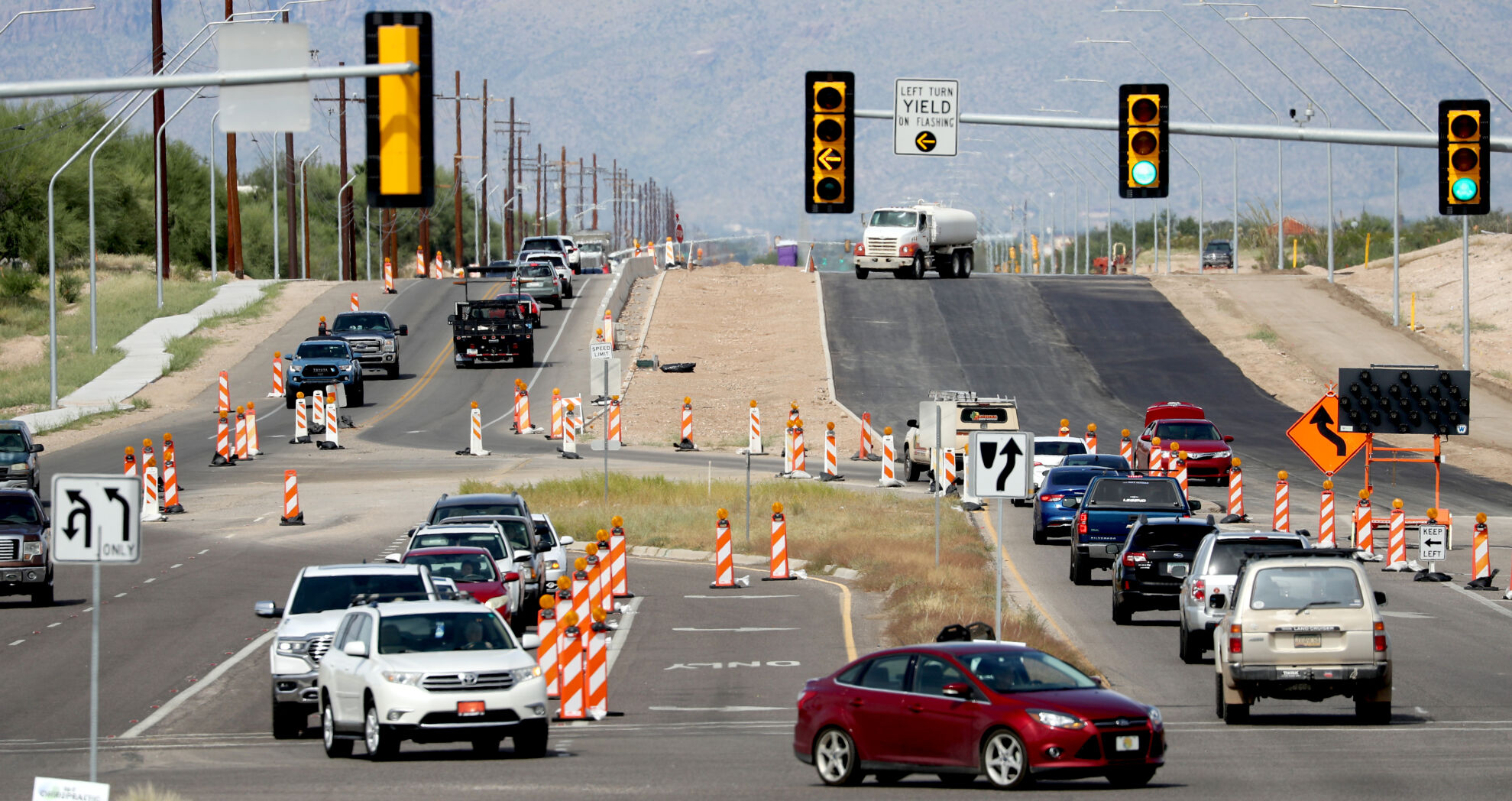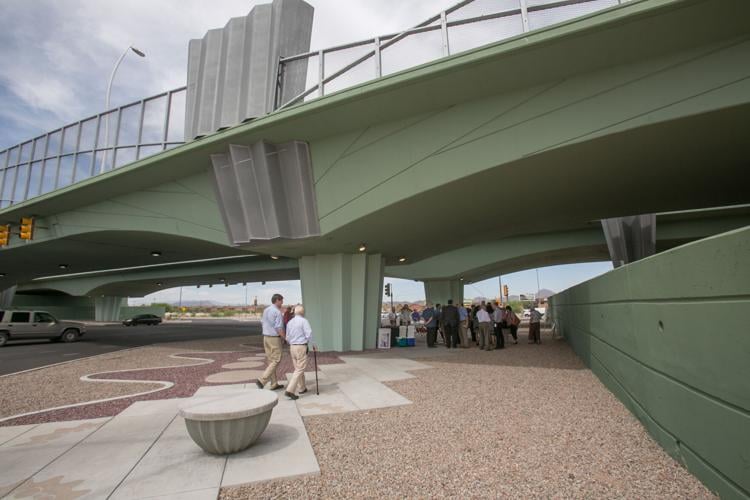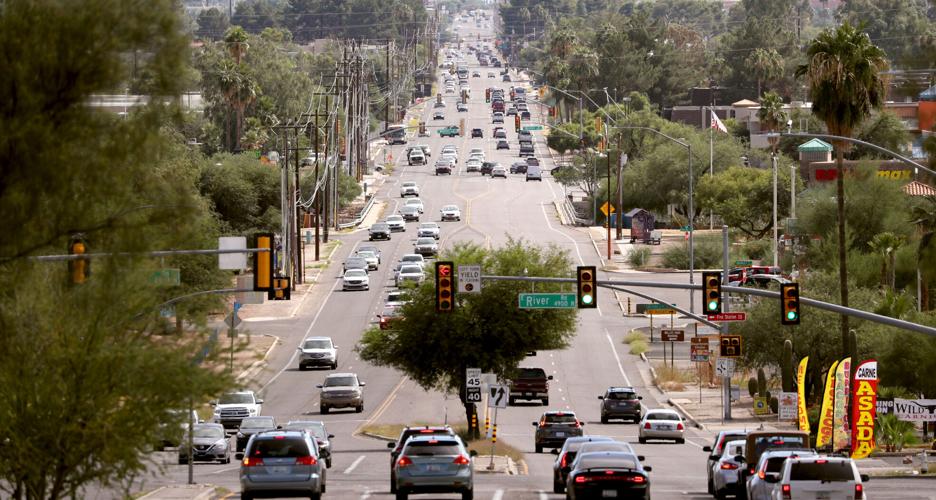Editor's Note: This article has been updated to correct the status of road work on Houghton Road between East Valencia and East Mary Ann Cleveland Way. Construction on that section of Houghton began last year.
Ten major road projects across Tucson are critically underfunded, putting them at risk of going unfinished unless a cash shortfall — estimated as high as $250 million — is fixed soon.
Residents have been counting on the projects since 2006 when voters across Pima County approved a Regional Transportation Authority sales tax to fund an assortment of work in the region.
Each of the troubled roadway projects has been successfully funded at the 2006 ballot amounts, according to RTA staffers who said the program is only responsible for meeting voter-approved funding levels.
But 15 years of inflation has made the improvements far more expensive. The RTA said Tucson is responsible for filling the gap and will provide extra cash only if it collects more tax revenue than expected — and it isn’t even required to do that.
Is the outcome that many of the projects could be different than what voters approved? That’s what happened recently with a project on North Fourth Avenue, where the city proposed a change to the plan to cover a nearly $30 million shortfall.
Projects with the largest funding shortages could have the highest chance of going unfinished if extra money doesn’t crop up by the time the RTA sales tax expires in 2026.
The city estimates that each of those projects will require an additional $28 million to $72 million before their goals — ranging from road widening to street drainage — can be realized.
Residents and city officials have also said some of those project improvements are desperately needed as a matter of safety.
Shortfall estimates between the city and RTA often vary significantly. That’s mostly due to unknown differences in cost analyses that may be reconciled closer to project construction. This list is based on the city estimates:

The Kino overpass at 22nd Steet was dedicated in 2017. The 22nd Street project has the largest funding gap of any RTA project in Tucson. The final stage of the project — widening 22nd from South Kino Parkway and Interstate 10, is underfunded.
1 — 22nd Street: I-10 to South Tucson Boulevard
City of Tucson projected funding needed: $72 million
RTA projected funding needed: $60 million
Status: Partially completed
Began construction: 2013
Estimated completion: 2026
The 22nd Street project has the largest funding gap of any RTA project in Tucson, according to city estimates. It covers a section of 22nd Street between Interstate 10 and South Tucson Boulevard.
The roadway project is designed to increase safety and mobility by widening 22nd Street, building bridges over railroad tracks and improving intersections.
Completed elements include a new intersection at South Kino Parkway and East 22nd Street, which was finished in 2015. Construction will also start next year for a new bridge over the Union Pacific Railroad tracks that’s fully funded.
The shortfall exists in the final stage of the project that will widen 22nd Street from two to three lanes in each direction between South Kino Parkway and I-10.
Community members may welcome a change to the scope of that roadwork, however. The project has been an issue for residents who are concerned about losing historical buildings in the area.
“I think it’s important to act cautiously, very carefully, because widening would take homes that are in the barrio, which harkens back to urban renewal,” said Ernie Luján, the president of the Barrio Santa Rita and West Ochoa Neighborhood Association.
City Councilman Richard Fimbres, whose ward includes the affected neighborhoods, said additional lanes may no longer be needed because of changes in traffic patterns.
He’s been working with neighbors to propose an adjustment to the project’s scope, an approach the city has used to cut costs in the past.
The RTA will still have to approve the idea and has historically shied away from large changes to voter-approved projects.
If the original plan stays in place and funding is secured, RTA staffers said the widening is unlikely to start until 2026 because of the time needed to plan, design and organize the construction of the project.

An indirect left intersection at Grant and Oracle roads was completed in 2013. Construction is expected to begin next year on Grant between North Alvernon and North Swan roads. But improvements to Grant between Campbell Avenue and Country Club Road remain unfunded.
2 — Grant Road: North Oracle to North Swan
City of Tucson projected funding needed: $57 million
RTA projected funding needed: $73 million
Status: Partially completed
Began construction: 2012
Estimated completion: 2026
The improvements along the section of Grant Road between North Oracle and North Swan include more travel lanes, safety features like bus pullouts, as well as a number of pedestrian-friendly upgrades and better bicycle lanes.
Road work was finished between North Stone and North Park Avenue in 2018, and construction is expected to begin next year on the fully funded section between North Alvernon and North Swan.
Those portions of the project flank the unfunded piece, creating a “doughnut hole” in the middle of Grant Road between North Campbell and North Country Club Road.
Planned improvements on that section include increasing the number of traveling lanes to six, widening sidewalks and adding protected pedestrian crossings.
“You can’t do two-thirds of the project and leave the middle-third undone, or it’s just shortchanging the community,” said Councilman Steve Kozachik of Ward 6, where part of the project is located.
Residents said they’ve spent countless hours to allow for the construction of the project, sacrificed historical homes to make space for more lanes, and lobbied to preserve other historical buildings that might have been affected by construction.
“I can not believe that funding for this central part of the project, which is the heart of Tucson’s northside inner-city, will not be forthcoming,” said Joan Daniels who’s lived in the area since 1972. “So many neighbors have been impacted and suffer loss of property value and increased noise to afford Tucson a highway through the city.”
The “doughnut hole” may be filled in 2026 if officials are able to overcome the $57-73 million gap in funding.

Traffic on a stretch of Silverbell Road just north of El Camino del Cerro. The Silverbell project, which aims to add two lanes in each direction on an 8-mile stretch between Grant and Ina roads, hit a snag with the discovery of archaeological artifacts.
3 — North Silverbell: West Ina Road to West Grant
City of Tucson projected funding needed: $32 million
RTA projected funding needed: $58 million
Status: Partially completed
Began construction: 2015
Estimated completion: 2026
The North Silverbell project will add two lanes in each direction on an 8-mile-long section of the street between West Grant and West Ina Road. Other improvements include a raised median for safety.
Aside from funding gaps, the project has faced unique issues that have complicated the pre-construction process: There are “significant archaeological resources” from West Goret to West El Camino del Cerro, the location of the project’s second phase.
Efforts to recover those artifacts had to take place before the second phase fully began. It’s now fully funded and expected to start in late 2022.
The final phase is facing a shortage of about $60 million, according to the highest estimate. The gap threatens roadway improvements on North Silverbell between West El Camino to West Ina Road.
The two-lane road currently gets far more traffic than it can handle, according to Craig Pohlman, the president of the Silverbell Residential Homeowners Association.
Pohlman said other aspects of the underfunded project, like drainage improvements, are also needed to make the road a safe place to travel.
“Silverbell Road between Goret Road and Ina Road is subject to frequent and sudden closures during storms, especially during the monsoon season because there are no drainage culverts or bridges over the washes that currently cross the road at ground level,” Pohlman said via email. “This year, a serious accident occurred just north of Goret after one storm.”
A new bridge from I-10 that’s located near North Silverbell is nearly completed and about 100 new homes are being built along the road, which could make the traffic issues worse ahead of the planned roadway improvements.
“Waiting any longer is a sure recipe for disaster for safety on Silverbell Road and those living in the community,” Pohlman said.
Time will be needed to “mitigate archaeology” along that stretch of the project as well. RTA staffers said construction probably won’t begin for another five years.
Road work between West Grant and West Goret is the only project goal to be completed so far. It was finished in 2017 and included street widening, bike lanes, and a multiuse path.
4 — Houghton: I-10 to East Tanque Verde Road
City of Tucson projected funding needed: $32 million
RTA projected funding needed: $55 million
Status: Partially completed
Began construction: 2009
Estimated completion: 2025-2026
Houghton Road represents one of the longest-running RTA projects in Pima County with an implementation timeline that spans the entire 20-year life of the program.
The project will widen 13 miles of Houghton between I-10 and East Tanque Verde Road. Other improvements include new drainage features and bridges along that route.
Many goals of the two-decade-long project have already been completed. The section of Houghton between East Irvington and East Valencia was widened in 2014, for example.
The funding gap exists along the piece of Houghton from East Broadway to East Tanque Verde. Tucson will need an additional $32-55 million to finish construction in that area.
Councilman Paul Cunningham, who represents the affected area in Ward 2, said the unfunded stretch of road presents a safety issue for motorists.
“During rush hour we have a traffic situation that’s actually unmanageable. It just becomes incredibly dangerous with the amount of congestion you have,” Cunningham said. “You pretty much have a bottleneck where they’ve approved the road outside of that area but they haven’t finished the whole thing, which was promised when they passed the RTA.”
The design phase for the underfunded section hasn’t been scheduled yet, according to the project’s website. RTA staff said construction is still expected to start in 2025.
Another remaining piece of the project, between East Valencia and East Mary Ann Cleveland Way, is fully funded and began construction last September. The section of Houghton from East 22nd Street and East Irvington is also fully funded.

The objective of the North First Avenue project was to increase the number of lanes between River and Grand roads from four to six, along with adding sidewalks and bike paths. But the City Council unanimously voted Sept. 28 to change the scope of the project, keeping the street’s width to four lanes.
5 — North First Avenue: East River Road to East Grant
City of Tucson projected funding needed: $28 million
RTA projected funding needed: $64 million
Status: Planned
Scheduled to begin construction: 2026
Estimated completion: 2026
The original objective of the North First Avenue project was to increase the number of lanes between East River Road and East Grant from four to six, along with adding sidewalks and bike paths.
The project may address what city staffers said is a “high volume of pedestrian and bicycle accidents” on North First.
An additional $28 million to $64 million is needed to complete all of the improvements that were approved by voters in 2006, but the Tucson City Council unanimously voted to change the scope of the project during its meeting on Sept. 28.
The alternative approach would eliminate the project’s funding gap by keeping the street’s width to four lanes. All other improvements in the original plan will still be in place.
“It turns out that traffic studies serving the community in a pretty wide spread fashion, found that four lanes would be sufficient,” Ward 3 Councilwoman Karin Uhlich said. “It turns out the preference is, from all kinds of constituencies, to scale it to a four lane versus six lane. I think the community will embrace that change.”
Over 1,000 residents were surveyed to gauge public support for the alternative project goal ahead of the council meeting. More than two-thirds of respondents said they preferred the four-lane option.
The change still has to be approved by the RTA before it’s finalized. That process will involve discussions between the city and the RTA staff about whether the new project scope is in compliance with the program’s rules.
No portions of the North First Avenue project have been completed yet, and it’s expected to begin construction in 2026. It’s unclear if the city’s proposed changes will alter that timeline.
South Houghton Road and all four Interstate 10 ramps connected to it will be closed the night of Sept. 15 before a new temporary traffic interchange is unveiled.
The I-10 ramps and Houghton Road between East Mary Ann Cleveland Way and East Brekke Road will be closed from 10 p.m. to 6 a.m. starting the night of Sept. 15, according to the Arizona Department of Transportation. The area will reopen around 6 a.m. on Sept. 16 and traffic will move on both sides of the median on the Houghton Road bridge.
The new temporary traffic configuration is part of the overall work being done for the Houghton Road-Interstate 10 project that will feature six lanes of traffic and new paths for pedestrians and bicyclists.
ADOT plans to switch traffic to the "diverging diamond" design this fall and the interchange project, which began in August 2020, is set to be completed by the end of this year. Drivers are advised to be careful and slow down when driving through the work zone on Houghton near I-10. Video courtesy of the Arizona Department of Transportation.







